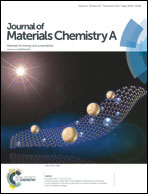Design and synthesis of cation-functionalized ionic liquid for application as electrolyte in proton exchange membrane fuel cells†
Abstract
Functional design was conducted for ionic liquid (IL) by introducing –SO3H to the cation, and an IL of N,N,N-trimethyl butylsulphonate ammonium hydrosulfate ([N1114SO3H]HSO4) was synthesized as the electrolyte in a proton exchange membrane fuel cell (PEMFC). Subsequently, a series of single cell tests was carried out, and the results show high cell performance for the PEMFC with the designed IL as the electrolyte. A maximum power density (MPD) of 90 mW cm−2 was obtained with the functionalized IL of [N1114SO3H]HSO4, while the MPD for the fuel cell with a similar but not functionalized IL can only provide an MPD of approximately 60 mW cm−2. Possible mechanisms behind the elevation of the fuel cell performance were investigated and discussed. The results show that the proton diffusion coefficient elevation of the functionalized IL is one important explanation for the increased fuel cell performance. Finally, theoretical calculation for the potential barrier for proton transportation in the two ILs was conducted. The results show that the potential barrier for the functionalized IL was lowered. All of these results imply that introducing a functional group to the cation is a promising way for a high proton conductive IL to function as the electrolyte in a PEMFC.


 Please wait while we load your content...
Please wait while we load your content...